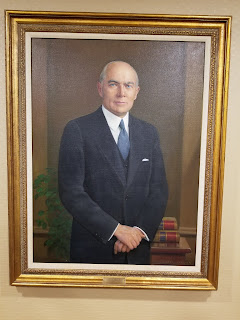This is my letter to Carolyn King Arnold and the supporting document.
LETTER
Edward H.
Sebesta
edwardsebesta@gmail.com
Carolyn
King Arnold
City
Council Board Member – District 4
1500
Marilla
Dallas,
TX 75216
Dear Hon.
Arnold:
Please
find enclose a write up on Dallas City Council renaming Floyd Road to Texas
Instruments Blvd. It includes all the information about the ordinance. Also,
enclosed is a Jan. 14, 1998 Dallas
Morning News article, “Council may let street be named for TI, Members
considering plan to allow honor for businesses.”
The key
thing to notice that the Dallas city council just changed the code to provide a
loop hole to allow the renaming. The
lesson to be learned that if there is a will there is a way.
Also, there
is no reason to have a three-quarters requirement as in the enclosed code. The
street renaming code in Dallas is written with the rather obvious purpose to
prevent streets being renamed after civil rights leaders. Else Faye Heggins
pointed this out when they were first proposed. They were sort of snuck in some
years later. They wanted to have a means to give the rich and powerful the
street names they wanted but to keep Marvin Crenshaw shut down.
There is
precedent for including some part in the ordinance allowing a bypass of the
Landmark Commission.
Having
the Landmark Commission involved I think is a very bad idea. I haven’t
researched the members’ backgrounds, but I strongly suspect that you have a
Commission composed of members who can’t give up the white landscape. The local
Dallas scene of preservationists and Dallas historians seems to be made of
those who have fine sounding phrases but can’t give up a racialized landscape.
Sincerely
Yours,
Edward
H. Sebesta
SUPPORTING DOCUMENT
Texas Instruments – Edward H. Sebesta 2/6/2019
This is
excerpted from a larger paper about the struggles over renaming streets in
Dallas for civil rights leaders. Basically the Dallas City Code is designed to
prevent the renaming of streets after civil rights leaders as Elsie Faye
Heggins pointed out when it was first proposed in the 1980s, but snuck in some
years later.
What it
shows is that there is precedent for changing code when it suits the city’s
purposes.
EXCERPT:
In
contrast to the struggle for a Malcolm X Blvd. was the catering to the interests
of giant semiconductor firm Texas Instruments then finishing a $2 Billion
dollar expansion in Far Northeast Dallas. Texas Instruments requested Floyd
Road be renamed Texas Instruments Boulevard. As reported in a Jan. 14, 1998, DMN article, “Council may let street be
named for TI, Members considering plan to allow honor for businesses.”
The
article mentions that elected officials “readily expressed support.” However
there is a problem per city code. As stated in the article, “The proposed name
change would violate a city policy prohibiting renaming streets for commercial
enterprises.” The city planners recommended that Texas Instruments’ request be
denied based on city policy. This didn’t prove to be an obstacle. The article
reports:
But the City Council may have
found a way to accommodate the global high-tech company: Change the rules.
On Wednesday, council members
will considering adopting a policy that would allow a three-quarters council
majority to waive street name restrictions on a case-by-case basis.
The
proposed name change is for only a part of Floyd Road violating another city
code policy that streets have one name along their entire length.
The
article talks about the economic importance of Texas Instruments locally which
given as a justification for the renaming without misgivings or questions.
The Floyd
pioneer family is considered, and they are happy to get a “plaque or kiosk on
TI property.” Preservation Dallas is not mentioned in the article. The
reduction of the extent of Floyd Road perhaps didn’t worry Preservation Dallas
or other historians and a “plaque or kiosk” on private property seemed to be an
adequate substitute. It would be interesting to see if a “plaque or kiosk” will
satisfy those in the future who argue against street renaming on the basis that
history will be lost.
There
isn’t concern that people would get lost or confused. Problems that are given
for not renaming other streets are not mentioned.
Marvin
Crenshaw took note of this catering to Texas Instruments. As the article
reports:
If the council agrees to give
itself the power to waive street-name restrictions, the city should expect a
host of requests to rename roads – not all of them from wealthy corporations,
said city activist Marvin Crenshaw.
Mr. Crenshaw, who led a 17-year
effort to rename a street for slain black nationalist leader Malcolm X, said
leaders were unwilling to bend rules during that campaign.
We’ll have to wait and see if the
council is willing to follow its new rules.” Mr. Crenshaw said.
This is
the code that would have prohibited naming the street after Texas Instruments.
SEC.
51A-9.304 Standards for Street Names and Street Name Changes.
(a)
In general
(4) A street name that uniquely identifies a particular tract,
tenant, or product name is prohibited.
This is
the information of the ordinance to just allow the usual provisions to be
waived. SEC. 51A-9.304 Standards for Street Names and Street Name Changes.
(g) Waiver.
The city council, by a three-quarters vote of its members, may waive any of the
standards contained in this section when waiver would be in the public interest
and would not impair the public health, safety, or welfare.
The
reason for three-quarters was to prevent the changing of street names for civil
rights leaders but be able to accommodate the rich and powerful.
WHERE
THERE IS A WILL THERE IS A WAY.
NEXT DOCUMENTATION ON THE PASSAGE OF THE
ORDINANCE
This is the code that was adopted.







